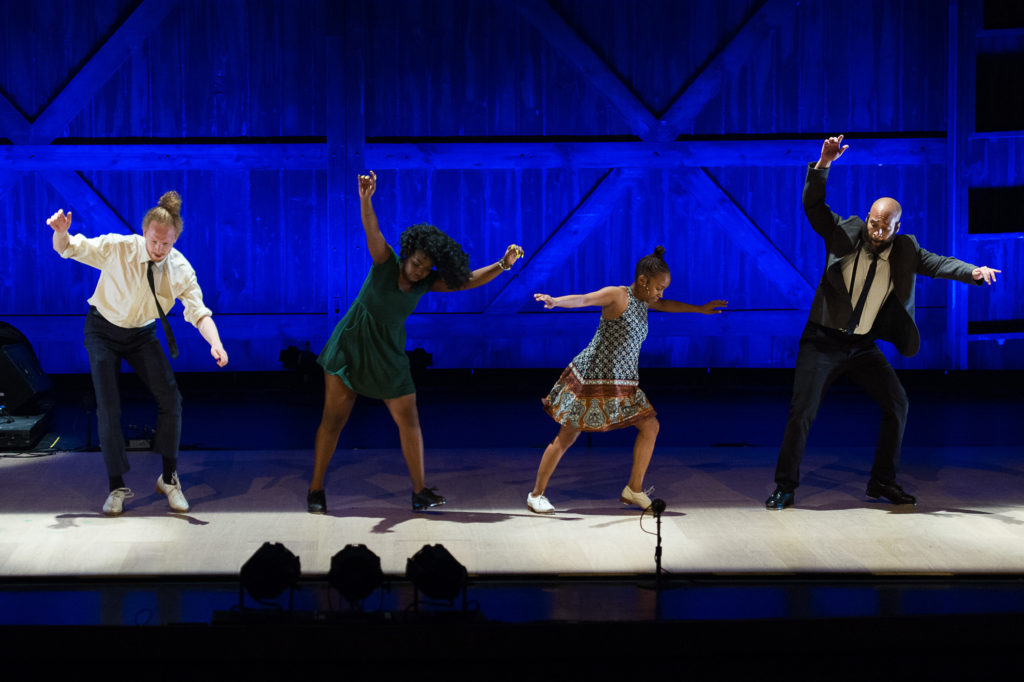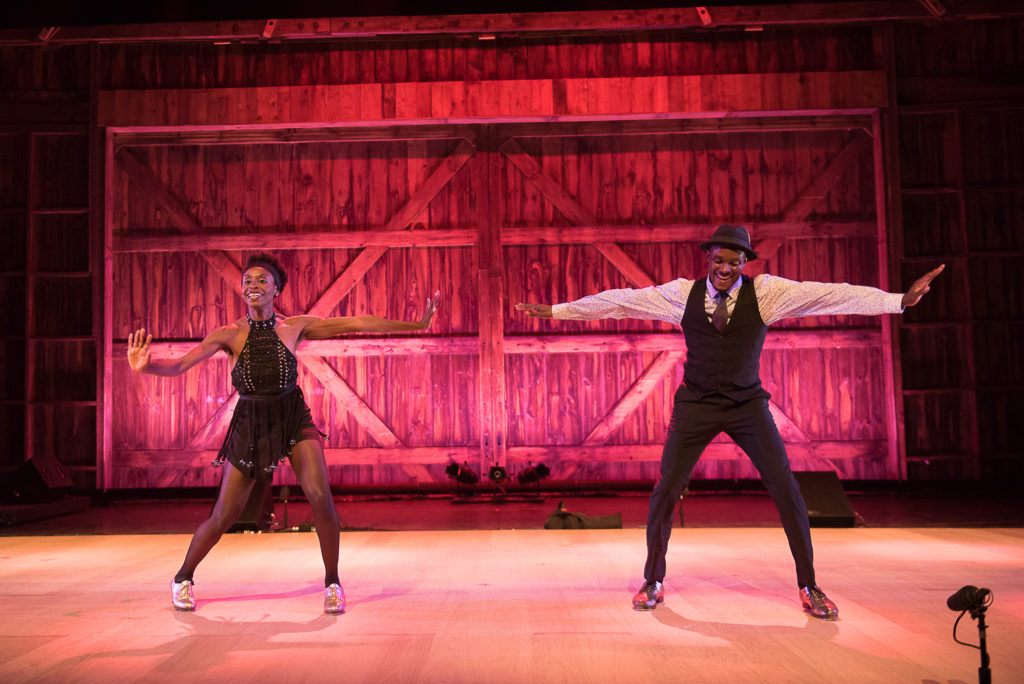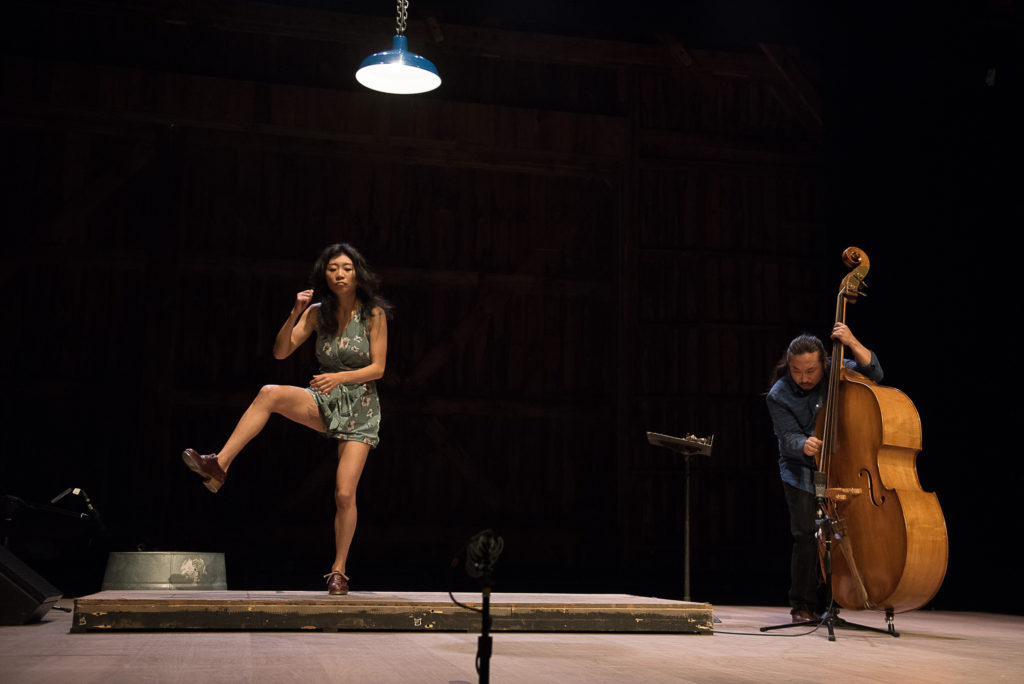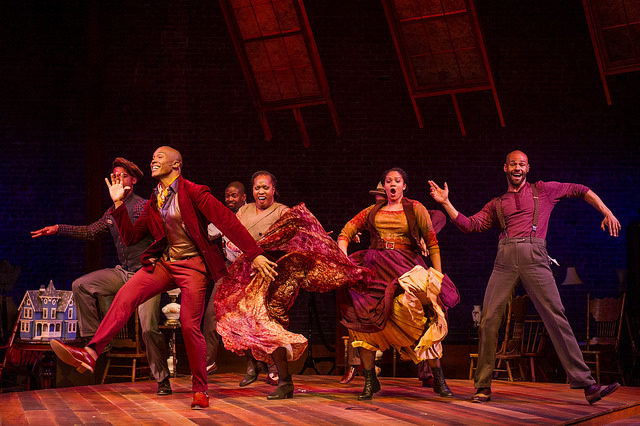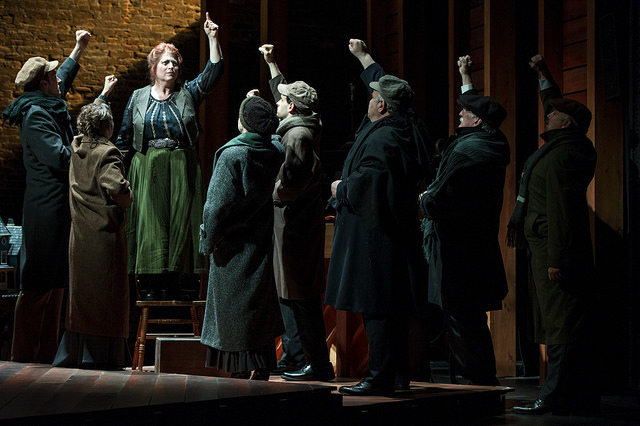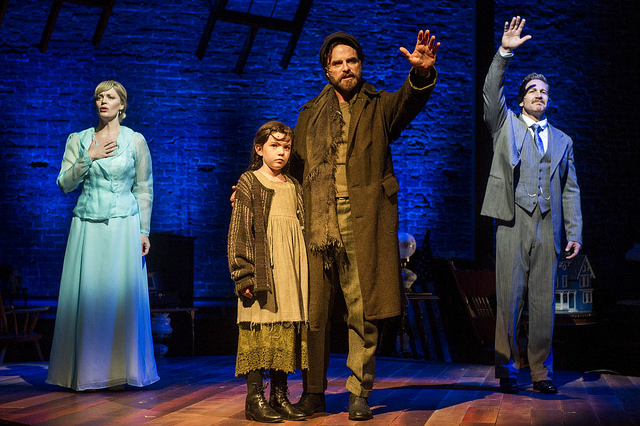Two shows now running in the Berkshires are rooted in the past but right up to the minute. Both Tireless, playing this week at Jacob’s Pillow, and Ragtime, at Barrington Stage through July 15, take their inspiration from the music of a bygone era while inviting us, implicitly but exuberantly, to reflect on our own times.
I don’t know why or when Ragtime was chosen as this season’s mainstage musical at Barrington Stage, but I’ll bet the selection had not a little to do with our current political climate. Based on E.L. Doctorow’s 1975 novel, it takes place in the early years of the 20th century, but the issues that propel it – racism, immigration, moneyed power – couldn’t be more timely.
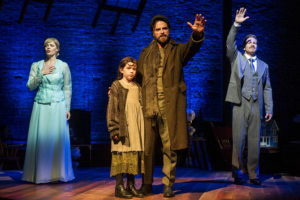 As if to emphasize the ties between that time and this, and the sense that so little has changed, director Joe Calarco sets the show in an attic full of the forgotten possessions of a long-gone generation. It begins with several of the leads stepping into it through a trap door, dressed in contemporary street clothes and changing into their period costumes (by Sara Jean Tosetti) as they examine the scattered memorabilia and the story’s other figures slowly filter onto the stage.
As if to emphasize the ties between that time and this, and the sense that so little has changed, director Joe Calarco sets the show in an attic full of the forgotten possessions of a long-gone generation. It begins with several of the leads stepping into it through a trap door, dressed in contemporary street clothes and changing into their period costumes (by Sara Jean Tosetti) as they examine the scattered memorabilia and the story’s other figures slowly filter onto the stage.
Terrence McNally’s script faithfully adapts Doctorow’s book and echoes his simple, straightforward prose, recalling the pre-World-War-One era in story-theater style, narrated by the characters. The score by Lynn Ahrens and Stephen Flaherty adds color, blending Broadway-flavored tunes with a grabbag of musical motifs drawn from early jazz and dance styles, along with the elegant ragtime of the title. And the large, diverse cast (more than a third are people of color) bring the interweaving plot threads vibrantly to life.
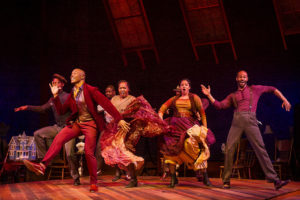 Those threads are personified by representatives of three distinct social strata whose lives crisscross and collide. Mother and Father (no proper names for this archetypal all-American family) head a prosperous household comfortably ensconced in suburban New Rochelle, N.Y. Coalhouse Walker, Jr., a gentlemanly black musician, responds resentfully and then violently when his dignity is demeaned and his status-symbol motor car trashed by a smirking racist.
Those threads are personified by representatives of three distinct social strata whose lives crisscross and collide. Mother and Father (no proper names for this archetypal all-American family) head a prosperous household comfortably ensconced in suburban New Rochelle, N.Y. Coalhouse Walker, Jr., a gentlemanly black musician, responds resentfully and then violently when his dignity is demeaned and his status-symbol motor car trashed by a smirking racist.
Tateh, a refugee from the pogroms of Eastern Europe, scrabbles a living for himself and his young daughter on the streets of the Lower East Side. (There’s a double meaning in the show’s title, as the steamers that brought impoverished immigrants to Ellis Island were disparaged as “rag ships.”)
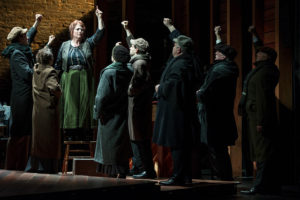 These fictional lives intersect with an emblematic sample of the era’s notables – celebrities Harry Houdini and Evelyn Nesbit, tycoons Henry Ford and J.P. Morgan, polar explorer Robert Peary, educator Booker T. Washington, agitator Emma Goldman.
These fictional lives intersect with an emblematic sample of the era’s notables – celebrities Harry Houdini and Evelyn Nesbit, tycoons Henry Ford and J.P. Morgan, polar explorer Robert Peary, educator Booker T. Washington, agitator Emma Goldman.
Calarco and choreographer Shea Sullivan deftly deploy their cast of 22 on Brian Prather’s simple set without overcrowding it. The blocking could have done with fewer downstage-center spotlight moments and tableau groupings, but overall there’s a satisfying balance between lively movement and intimate exchanges, subtly lit by Chris Lee.
In the large, impressive cast, I particularly enjoyed Darnell Abraham’s Coalhouse, matching a magnetic charisma to his outraged pride; Elizabeth Stanley as Mother, proper and corseted but ultimately shedding the latter, literally as well as figuratively; J. Anthony Crane, vigorously embodying the immigrant’s gritty hopefulness as Tateh; Hunter Ryan Herdlicka as Mother’s volatile Younger Brother; and my early-season best-supporting-actress candidate, Anne L. Nathan as fireplug-shaped firebrand Emma Goldman.
Jar the Floor
In a lobby at Jacob’s Pillow dance festival, there’s a four-wall exhibit of photos and posters from past seasons. It’s titled “Jump,” and every one of the pictured dancers is airborne, many of them impossibly so, captured in flight without a foot on the floor. Tap dance, by contrast, requires contact with the floor, as the dancer-musicians’ feet create the rhythm of their movements.
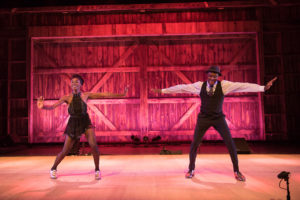 Tireless: A Tap Dance Experience, playing through this weekend, is a diverse, international showcase “curated” by Michelle Dorrance, the doyenne of modern tap. In her curtain speech on opening night, she emphasized the deep roots of today’s tap renaissance. “Tap comes from oppressed origins to transcend those origins,” she said, indicating that contemporary practitioners are both innovators and conservators, honoring the tradition while pushing its boundaries.
Tireless: A Tap Dance Experience, playing through this weekend, is a diverse, international showcase “curated” by Michelle Dorrance, the doyenne of modern tap. In her curtain speech on opening night, she emphasized the deep roots of today’s tap renaissance. “Tap comes from oppressed origins to transcend those origins,” she said, indicating that contemporary practitioners are both innovators and conservators, honoring the tradition while pushing its boundaries.
The four-part showcase richly proved that point, beginning with a kind of backgrounder from the brother-sister duo of Joseph Wiggan and Josette Wiggan-Freund, who, as Dorrance told us, “embody the vernacular tradition like no one else.” Accompanied by the music of Duke Ellington and a new composition dedicated to him, their footwork combined perfect unison with intricate counterpoint. Their showmanship was enhanced by dazzling smiles – not the fixed grins of show-biz gaiety but a spontaneous expression of pure enjoyment in the dance itself and in sharing it with us.
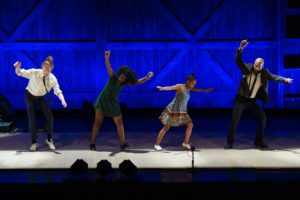 Two of the pieces featured a live jazz combo. “Supreme Love,” created by Jumaane Taylor and performed by him and three athletic colleagues, had a score inspired by and incorporating John Coltrane’s iconic “A Love Supreme.” Here the genre’s African, feet-on-the-earth roots were explicitly honored, beginning with an obeisance to the ancestors, and the tap steps created African polyrhythms within tightly synchronized routines.
Two of the pieces featured a live jazz combo. “Supreme Love,” created by Jumaane Taylor and performed by him and three athletic colleagues, had a score inspired by and incorporating John Coltrane’s iconic “A Love Supreme.” Here the genre’s African, feet-on-the-earth roots were explicitly honored, beginning with an obeisance to the ancestors, and the tap steps created African polyrhythms within tightly synchronized routines.
The most ingenious in concept, but to my mind the least successful of the evening’s turns was Joe Orrach’s “In My Corner,” a words-and-movement account of his personal journey from a high-school athlete and troublemaker to a dancer grounded in the footwork of the boxing ring. Orrach is a disarmingly personable narrator, but I found his one-man memoir an unexceptional instance of that overdone genre and the sporadic moments of illustrative rhythm and movement largely forced and awkward – for instance, partner-dancing with a punching-bag frame on wheels.
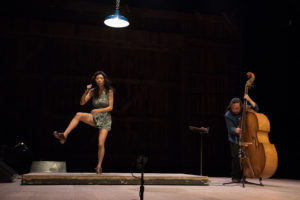 For me, the show’s Wow! factor hit the high note in “Aun,” performed in tap shoes by Reona Seo and on double bass by her husband Takashi (who also played in the show’s jazz combo). This was emphatically a duet of equals, not dance accompanied by music – and both elements were completely improvised. In what Dorrance described as the embodiment of “free jazz,” the duo seamlessly, intuitively swapped lead-and-follow till it often wasn’t clear who was following whom. Takashi’s bass matched Reona’s moves rhythmically, tonally and texturally (his bow positively danced on the strings) – and vice versa. Reona’s feet were sometimes explosively percussive, sometimes so still you wouldn’t think they were moving except for the subtlest ripples of sound rising from the floor.
For me, the show’s Wow! factor hit the high note in “Aun,” performed in tap shoes by Reona Seo and on double bass by her husband Takashi (who also played in the show’s jazz combo). This was emphatically a duet of equals, not dance accompanied by music – and both elements were completely improvised. In what Dorrance described as the embodiment of “free jazz,” the duo seamlessly, intuitively swapped lead-and-follow till it often wasn’t clear who was following whom. Takashi’s bass matched Reona’s moves rhythmically, tonally and texturally (his bow positively danced on the strings) – and vice versa. Reona’s feet were sometimes explosively percussive, sometimes so still you wouldn’t think they were moving except for the subtlest ripples of sound rising from the floor.
The Pillow’s ten-week season continues next week with two women-led companies – Jessica Lang Dance in a program of “skillfully constructed dances that respectfully mesh with music and striking visual design” and Faye Driscoll and company, whose “unpredictable, funny and endlessly entertaining” Thank You for Coming, part one of a projected trilogy, “softens the borders between artist and audience.”
Ragtime photos by Daniel Rader
Jacob’s Pillow photos by Christopher Duggan
If you’d like to be notified of future posts, email StageStruck@crocker.com

